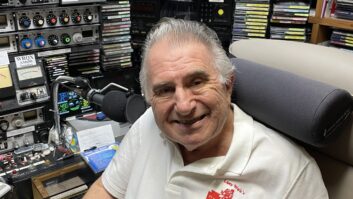In 1951 Hank Williams Sr. recorded a song called “I Can’t Help It.” That may be a suitable theme for Ray Davis, who already had been on the radio playing country and bluegrass music for three years by that point.
Davis had left his home in Wango, Md., at age 15 to take a job at WDOV(AM) in Dover, Del. He just can’t help playing and recording the type of music he loves. Now 75, he’s been at it for 60 years.

Ray Davis at work, in a 2004 photo. Photo courtesy Garland M. Gobble
“When I got the offer to leave home and take that job, my mom gave me her permission,” said Davis. “In fact she drove me up there and looked the place over. Later, after I had been on the air for a while, if the mailman or anyone else would come by, she would tell him that her son was on the radio. I was making $50 a week and it was great!”
By the mid-1950s, Davis had made an interesting career move, to XERF(AM), a booming 250,000-watt brokered station just over the Mexican border from Texas.
“I sold every kind of product on the air,” said Davis. “You had to ad-lib copy back then and you could tell if you were doing OK by how many orders came in.
“They had a mailroom in Del Rio, Texas, where I lived. It was huge. I’d drive across the border every day to work at the station, which was in this compound with armed guards. One night when I was leaving, I found a scorpion in my car.”
Multicast
Long before Ronco’s Vegamatic, Davis had his own unique items to peddle.

CDs from Davis’s show include includes songs from the Stanley Brothers (1963), the Gillis Brothers (1993), The Basement Band (1998) and the Warrior River Boys (1998).
“The weirdest thing I ever pitched on the air was something called the ‘Walk-Away,'” he said. “That was a concoction that claimed to cure rheumatism or something. I said on the air that it was made from the sands of the testing grounds of the atomic bomb. That product was only on for a few days.”
Homesick, Davis left Texas and returned east to work for several more traditional stations. For 38 years, he hosted a bluegrass program from Johnny’s Used Cars for WBMD(AM) in Baltimore. In 1985 he landed his current job, one that allows him the freedom to select his own music. As anyone who has worked in radio for more than 10 minutes knows, this a rarity in contemporary radio.
“I’m heard now on the HD-2 channel of WAMU(FM), the public station of American University in Washington, D.C.,” he said. “I do five live shows every week from my house, and with one recorded repeat, I’m heard six days a week. I use a Radio Systems board. Because we’re on the Internet, we’ve gotten listener response from all over the world.”
How does he feel about having been moved to the multicast not long ago?
“Well, I think I had more listeners on the main channel, but we’re growing all the time. I can tell when we do fundraisers that people are listening because we get a lot of response from this area. We’ve just added a translator in Vienna (Reston), Va., at 105.5 FM and that ought to help.”
As to HD Radio in general, “I’ve had people buy ’em just so they can hear my show, because I have a loyal audience. But HD Radios are real hard to find in the stores. I think the economy affects everything. People who might have gone out and gotten one might not do it now that things are so slow. HD Radio hasn’t been promoted well, but I’m comfortable with it. At WAMU, we’re committed to it in a big way.”

Ray Davis in Baltimore, 1951. Davis, heard Sundays at 10 a.m. and weekdays at 3 p.m. at www.wamu.org, provides exposure for a musical genre that banjo player Ralph Stanley used to call mountain music but what is currently known as bluegrass.
Unlike almost any other radio personality in the business, Ray Davis records much of what he plays on the air in his own studio.
All together now, 1-2-3
One of the features on his radio show is “Basement Tapes.” That is an accurate name because Davis’ personal studio actually is in his basement, a room that has been the recording home for some of the biggest names in bluegrass.
“When I started, bluegrass was a form of country music, the poor man’s country music,” he said. “But it was what I liked. You had people like Bill Monroe, The Stanleys, Don Reno and Red Smiley. They all recorded in my basement.
Dear Ray The following is a sampling of comments sent to Ray Davis on the occasion of his 60th anniversary on the air.
“Congratulations on your 60 year ride on the airwaves. I might be one of a very few that has been with you the whole time. As a five-year-old I listened with my parents on WBMD and also heard you with an outside antenna when you were “south of the border.” Keep the bluegrass coming for another 60 years and I’ll try to ride along.
“Your 60th anniversary is a milestone few obtain, and the class you have shown is beyond reproach. I too, enjoy all your “Plum Pitifuls” and the spirituals. Every time your show comes on I listen religiously. You are so kind with the listeners who lose their loved ones who are steady listeners. Thank you for your compassion and especially, for your kind words when I lost my wife.
“You have no idea how much your shows mean to our family. We’ve been listening to bluegrass on WAMU since moving here in 1995. Our kids have grown up with you and when you moved to HD, we ran to get the right radio so our Sunday would be the same as ever. Your show has introduced us, and thousands of other people, to so many amazing artists. Thank you for continuing the tradition with your broadcasts. We love your stories.” “The studio isn’t big enough, but I make it work. I have the best fiddle player around, a guy named Mike Cleveland. My wife Nona cooks us a meal upstairs, and everyone has a good time. I usually pick the material to record and I know what I want for my radio show. I also know how I want it to sound.”
In recording studios today, each instrument can be recorded separately, and many of those instruments are synthesized. But that is not the way it goes down in Ray’s basement.
“The secret? Know what you’re looking for,” he said. “I have to feel it or I’m not satisfied. I’m not bragging, but I know what my audience wants and I try to give it to them. I use a Mackie board for recording, and while it’s 24-channel, the trick is to record everybody at once. I very rarely overdub because I want the music to have a live feel to it. I’ve always done it that way, even back before there was stereo.”
Davis is aware of current recording techniques but believes he gets a more natural sound with everyone in the same cramped recording studio, pickin’ and grinnin’ at the same time.
“There is just a better chemistry this way. If everyone is in the song together, they feel it and it shows up on the record,” he said.
Various Basement Tapes are available on CD as premiums for new members of WAMU.
When it comes to bluegrass music, Ray Davis is not only preserving a part of Americana, he is creating it.
As a side note, it was Radio World Editor in Chief Paul McLane who sold Davis the Radio Systems board that is used to create Davis’ shows, years before McLane joined the staff of this publication.
“And you can tell Paul for me that it’s a great board and it’s still workin’ fine,” said Davis.
Learn more about Ray Davis at bluegrasscountry.org/programs/the-ray-davis-show.












